How to Make an Atomic Bomb :핵폭탄 만드는 법
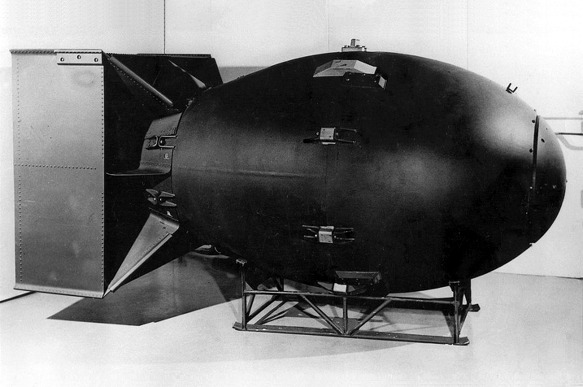
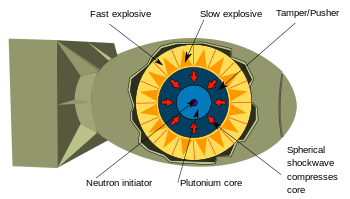
Implosion-type weapon
Fat Man, the Nagasaki bomb, used 13.6 lb (6.2 kg, about 12 fluid ounces or 350 ml in volume) of Pu-239, which is only 41% of bare-sphere critical mass. (See Fat Man article for a detailed drawing.)
Surrounded by a U-238 reflector/tamper, the pit was brought close to critical mass by the neutron-reflecting properties of the U-238. During detonation, criticality was achieved by implosion.
The plutonium pit was squeezed to increase its density by simultaneous detonation of the conventional explosives placed uniformly around the pit. The explosives were detonated by multiple exploding-bridgewire detonators. It is estimated that only about 20% of the plutonium underwent fission; the rest, about 11 lb (5.0 kg), was scattered.
Implosion Bomb Cross Section (drawn to scale)
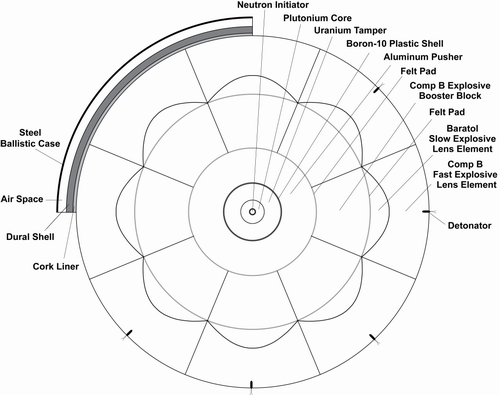
Scale drawing of Fat Man
How to Make an Atomic Bomb
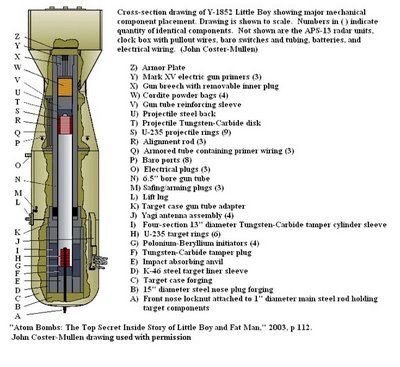
Little Boy and Fat Man
This idea suddenly came in my mind that how does an atom bomb works. I have no all idea that how does it works, but I have a bit idea that somewhere we need uranium or plutonium to do this type of explosions or to make a nuclear bomb. actually, all this happen through chain reaction of atomic energy. I hope this article will help you to understand the nuclear fission or chain reaction of atomic bomb. So, lets start from here, today at what you need in order to make a nuclear fission bomb.
You need some money, as it would really help if you were the prince, sultan or other royalty of a small, but rich state. If not, you need to know on a first name basis some evil leader with lots of cash, oil, diamonds and so on, of a small but ambitious country, with a need for revenge on the world.
Step 1 - What is a nuclear fission bomb?
Fission bombs derive their power from nuclear fission, where heavy nuclei (uranium or plutonium) are bombarded by neutrons and split into lighter elements, more neutrons and energy.
These newly liberated neutrons then bombard other nuclei, which then split and bombard other nuclei, and so on, creating a nuclear chain reaction which releases large amounts of energy.
These are historically called atomic bombs, atom bombs, or A-bombs, though this name is not precise due to the fact that chemical reactions release energy from atomic bonds (excluding bonds between nuclei) and fusion is no less atomic than fission. Despite this possible confusion, the term atom bomb has still been generally accepted to refer specifically to nuclear weapons and most commonly to pure fission devices.
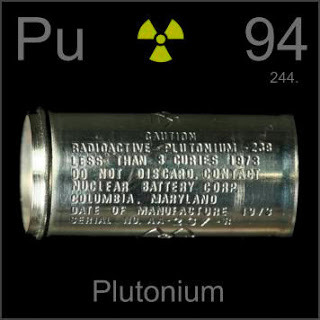
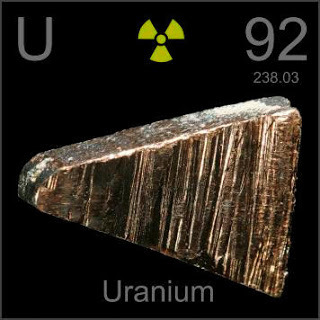
Step 2 - What do you need?
a. The fissionable material 핵분열 물질
Plutonium239 isotope. Around 25 pounds (10 kg) would be enough. If you could find some Uranium235, that would be good, but not great. You would need to refine it using a gas centrifuge.
The uranium hexafluoride gas is piped in a cylinder, which is then spun at high speed. The rotation causes a centrifugal force that leaves the heavier U-238 isotopes(동위원소) at the outside of the cylinder, while the lighter U-235 isotopes are left at the center. The process is repeated many times over through a cascade of centrifuges to create uranium of the desired level of enrichment.
To be used as the fissile core of a nuclear weapon, the uranium has to be enriched to more than 90 per cent and be produced in large quantities.
You could try buying it from a former Soviet Republic, or from Iran, since they're trying so hard to produce it. North Korea is not ready yet, and unfortunately, Iraqi dealers retired from the business.
b. The explosive to start the nuclear chain reaction 핵연쇄반응 일으킬 폭발물
100 pounds (44 kg) of trinitrotoluene (TNT). Gelignite (an explosive material consisting of collocation-cotton (a type of nitrocellulose or gun cotton) dissolved in nitroglycerin and mixed with wood pulp and sodium or potassium nitrate) would be better. Semtex would be good too, but it's a bit hard to get, these days.
c. The detonator 기폭장치
To fabricate a detonator for the device, get a radio controlled (RC) servo mechanism(무선조정제어장치), as found in RC model airplanes and cars. With a modicum of effort, a remote plunger can be made that will strike a detonator cap to effect a small explosion. These detonation caps can be found in the electrical supply section of your local supermarket. If you're an electronics wiz, you should be able to make it using a cellphone.
d. The pusher
The explosion shock wave might be of such short duration that only a fraction of the pit is compressed at any instant as it passes through it. A pusher shell made out of low density metal such as aluminium, beryllium, or an alloy of the two metals (aluminium being easier and safer to shape but beryllium reflecting neutrons back into the core) may be needed and is located between the explosive lens and the tamper. It works by reflecting some of the shock wave backwards which has the effect of lengthening it. The tamper or reflector might be designed to work as the pusher too, although a low density material is best for the pusher but a high density one for the tamper. To maximize efficiency of energy transfer, the density difference between layers should be minimized.
Diagram of a gun-type fission weapon
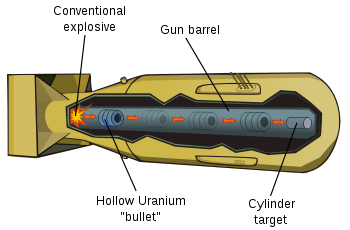
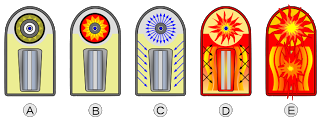
Step 3 - How to build the nuke?
You will need to get the fissile material to the critical mass in order to start the chain reaction, which depends upon the size, shape and purity of the material as well as what surrounds the material. Your weapons-grade uranium will have to be in sub-critical configuration(준임계 상태).
First, you must arrange the uranium into two hemispherical shapes(반구형의 모양), separated by about 4 cm. Since it's highly radioactive, the best way do it is to ask the friend owning the small country to let you use one his facilities. You could use a nuclear plant, a steel factory or even a well equipped pharmaceutical installation as a disguise for your plans.
It is not sufficient to pack explosive into a spherical shell around the tamper and detonate it simultaneously at several places because the tamper and plutonium pit will simply squeeze out between the gaps in the detonation front. Instead, the shock wave must be carefully shaped into a perfect sphere centered on the pit and traveling inwards. This is achieved by using a spherical shell of closely fitting and accurately shaped bodies of explosives of different propagation speeds to form explosive lenses.
After a few careful calculations, all you need now is to carefully pack and transport your nuclear bomb to the targeted location. If you happen to be an Al-Qaeda fan, you should try to infiltrate a military facility, for the psychological effect. Watch it, though, they are usually well guarded!
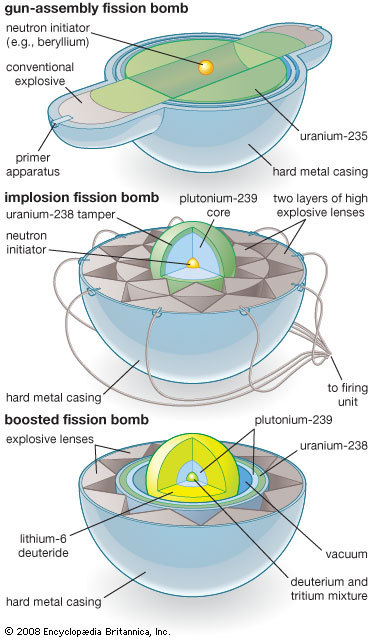
Fission bomb designs.
The three most common fission bomb designs vary considerably in material and arrangement. Encyclopædia Britannica, Inc.
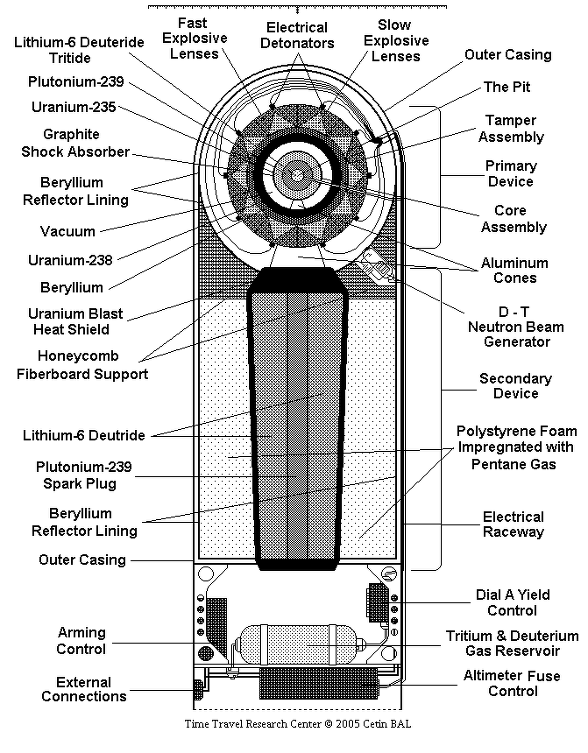
This is a model of a basic Teller-Ulam atomic bomb.
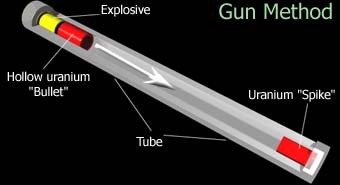
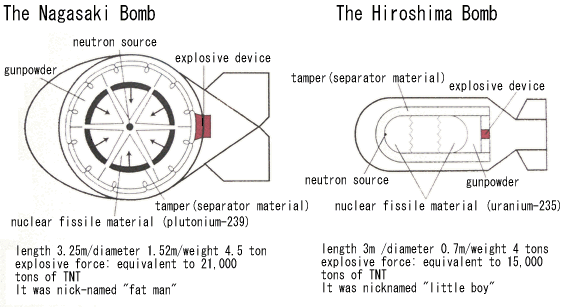
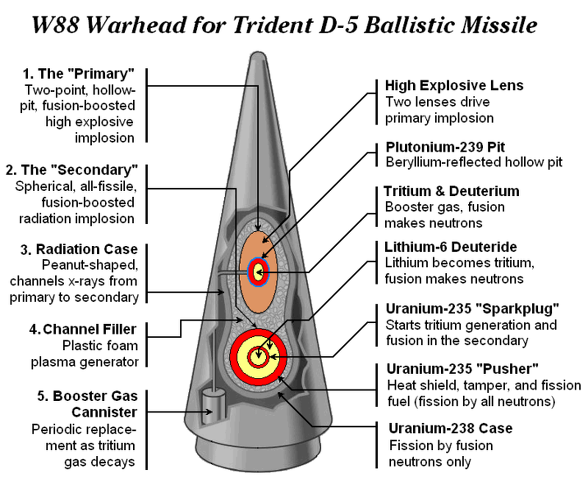
The W88 Warhead / Intermediate yield strategic SLBM MIRV warhead
Yield 475 Kt
Weight <800 lb="" p="">Length 68.9 in RV Base Diameter 21.8 in Nose Half Angle 8.2 degrees Number In Service 400
Trident II SLBM(잠수함발사탄도미사일) MIRV(다탄두미사일)

No comments:
Post a Comment